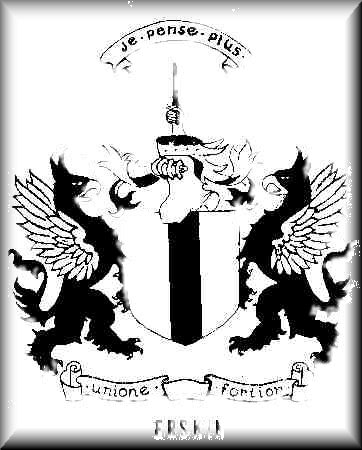

The Erskines were originally a Lowland family
who inherited through marriage the Earldom of Mar, the most ancient
of Celtic earldoms, and thus became allied to the principal Highland
families. Their name comes from the fertile lands of Erskine in Ren-
frewshire, on the south banks of the River Clyde, and derives from
the Brythonnic Celtic (Welsh) 'y ysigyn', the green slope, which
perfectly describes the topography. Although the
barony of Erskine does not appear among the lands granted by
Malcolm IV, to Walter, High Steward of Scotland, it is likely the
Erskines were of native stock and became vassals of the Stewarts. The
first on record is Henry de Ereskyn whose signature appears as
witness to a charter of Paisley Abbey in 1226 A.D., in the reign of
Alexander II. His castle stood where the new Erskine bridge scans the
Clyde.
Sir Robert de Erskine of that Ilk, the worthy,
wyse and lele', was High Chamberlain of Scotland in the late14th
century. He supported the cause of David II against the resurgent
Balliol faction, and later, in 1357, helped secure the king's release
from captivity in England. He was rewarded with the important office
of Constable of Stirling Castle and in 1368 was granted the lands of
Alloa in Clackmannanshire where he built a fortified house. All of
these are still held by his descendants today. He was also Ambassador
to France, England and the Papal See. He supported the claim of the
High
Stewards to the Scottish monarchy and assisted Robert II ascend the
throne in 1371. As an old ballad says, "Robert Stewart was made King,
Specially throw the helping, Of gude Schir Robert Erskine"
Sir Robert purchased the lands of Dun near
Montrose in north-east Scotland in 1358. These were later granted to
his younger grandson, John, who founded the line of Erskines of Dun.
These were the most prominent of the various cadet families until the
last in the male line died in 1812. Their House of Dun is now a hotel
and their town house in Montrose now a local newspaper office. The
local church-yards hereabouts are full of Erskine stones. The other
principal cadet line was the Erskines of Pittodrie in Aberdeenshire.
His son, Sir Thomas Erskine, married Janet in
1352, great-granddaughter of Gratney,
7th Earl of Mar, and the Lady Christian, sister of King Robert the
Bruce. The Earldom of Mar was the most ancient of the nine great
provinces of Scotland and its origins are lost in
the mists of antiquity. It was originally part of the northern
Pictish kingdom and descended through a Pictish heiress to Donald
MacEmin, Mormaer of Mar (Great Steward), who fell at the battle of
Clontarf near Dublin in 1014 repelling the Viking domination of
Ireland. The incoming Norman influence in Scotland brought changes to
titles as the Viking 'Jarl' became anglified to 'Earl', and in 1114
the Mormaer of Mar signed a charter as 'Earl Ruadhri', and he
is reckoned as the 1st Earl of Mar. The direct male line of Celtic
Earls died out in 1374 with the death of Thomas of Mar, Great
Chamberlain of Scotland. He was succeeded by his sister, then by her
daughter Isabella, Countess of Mar, who married Alexander Stewart, a
natural son of the fearsome Wolf of Badenoch but they had no heir.
In 1438, Sir Robert Erskine of that Ilk was
created Lord Erskine, and on the death of Alexander Stewart he became
13th Earl of Mar by 'right blood and line', being the nearest blood
relation to Isabella of Mar. He took occupation of Kildrummy Castle
in Aberdeenshire by force but Robert retaliated by confiscating the
Erskine lands in Alloa and Sir Robert was
forced to relinquish the Mar estates Aberdeenshire. The king
wrongly insisted the Earldom of Mar belonged the Crown because of its
Stewart connection and in 1457 reserved the right to the title. The
Earldom of Mar was then firstly and falsely bestowed on Prince John,
son of James II, then 1482 on Prince Alexander. In 1486 was given to
Prince John, son of Jame III, and finally in 1562 Queen Mary gave it
to her natural brother James Stewart. All of these title holders were
eventually declared void.
Alexander, 3rd Lord Erskine, and de jure
(rightful) 15th Earl of Mar, was given the guardianship of the young
James IV, and this was the start of the Erskines' hereditary
guardianship of five generations of royal heirs. Alexander built a
massive tower house in Alloa in 1497 with eleven-foot thick walls,
and this was the home of the Erskines for the next three centuries
Alexander's son Robert, 4th Lord Erskine and 16th Earl of Mar, was
killed
at Flodden in 1513 along with his king. Fighting beside him was his
relative, Erskine of Dun and his two sons, who were all also killed.
John, 5th Lord Erskine was given the guardianship
of the young James V from 1513-28, and later James Stewart,
illegitimate son of James V and finally in 1543 the nine-month old
Marv, Queen of Scots, was given into his care. She was to spend the
first five years of her life at Alloa Tower and Stirling Castle. His
son James, 6th Lord Erskine, was created Earl of Mar by Mary Queen of
Scots in 1565, who was moved by conscience' to correct the
errors of her predecessors. But what she should have done was simply
confirm him in the older title for, by her action, she effectively
created two Earldoms, the ancient one and the new creation. This was
to cause major headaches for later peerage lawyers, and led to the
eventual splitting of the title. You can now download a copy of this document in
MSWord format.
|
|